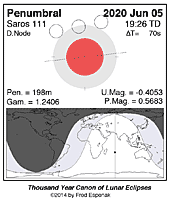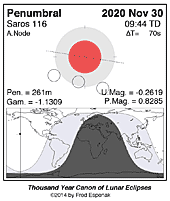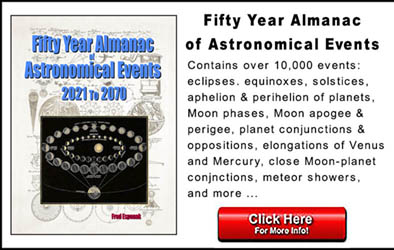Eclipses During 2020
By Fred Espenak
Based on the Article Published in
Observer's Handbook
2020
,
Royal Astronomical Society of Canada
In 2020, there are two solar eclipses and four penumbral lunar eclipses:
Predictions for the eclipses are summarized in Figures 1, 2, 3, 4, 5, and 6. World maps show the regions of visibility for each eclipse. The lunar eclipse diagrams also include the path of the Moon through Earth's shadow. Contact times for each principal phase are tabulated along with the magnitudes and geocentric coordinates of the Sun and Moon at greatest eclipse.
Unless otherwise stated, all times and dates used in this publication are in Universal Time or UT1 [1]. This astronomically derived time system is colloquially referred to as Greenwich Mean Time or GMT. To learn more about UT1 and how to convert UT1 to your own local time, see Time Zones and Universal Time.
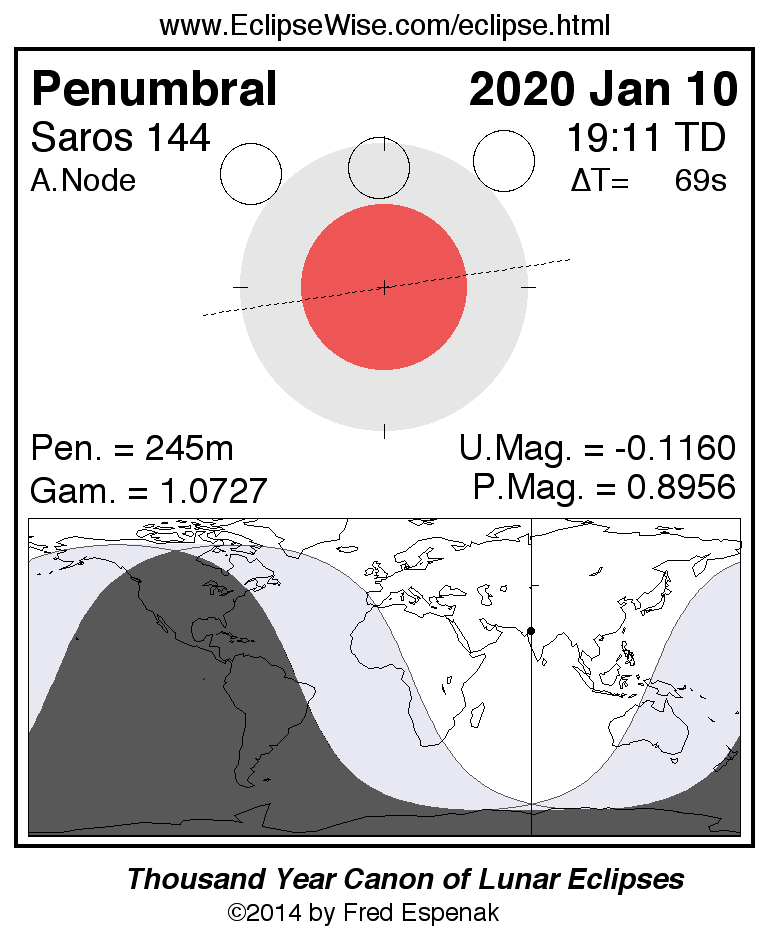
Click for larger more detailed figure
Penumbral Lunar Eclipse of 2020 Jan 10
Under Construction
The first event of the year is a penumbral lunar eclipse occurring at the lunar orbit's ascending node in Gemini. The apparent diameter of the Moon is larger than average since the eclipse occurs 3.0 days before perigee. The Moon's orbital trajectory takes it through the northern part of Earth's penumbral shadow.
The Moon's path through Earth's shadow and a map illustrating worldwide visibility of the event are shown in Figure 1. The times of the major eclipse phases are as follows.
Penumbral Eclipse Begins: 17:07:45 UT1
Greatest Eclipse: 19:10:02 UT1
Penumbral Eclipse Ends: 21:12:25 UT1
At the instant of greatest eclipse [2] (19:10:02 UT1), the Moon lies at the zenith for a point in northwest India near Ahmedabad. The penumbral eclipse magnitude [3] is quite deep and peaks at 0.8956. This is close to being a total penumbral eclipse - the northern edge of the lunar limb lies just 3.7 arc-minutes outside the penumbral shadow.
Note that the beginning and end of a penumbral eclipse are not visible to the eye. In fact, no shading can be detected until about 2/3 of the Moon's disk is immersed in the penumbra. This would place the period of eclipse visibility within about 1/2 hours of greatest eclipse (about 18:40 to 19:40 UT1). Keep in mind that this is only an estimate. Atmospheric conditions and the observer's visual acuity are important factors to consider. An interesting exercise is to note when penumbral shading is first and last detected with the naked eye or binoculars.
The eclipse belongs to Saros 144 [4] and is number 16 of 71 eclipses in the series. All eclipses in this series occur at the Moon's ascending node. The Moon moves southward with respect to the node with each succeeding eclipse in the series and gamma [8] decreases. Complete details can be found at Saros 144 .
For more information about this eclipse, see the EclipseWise Prime Page on the Penumbral Lunar Eclipse of 2020 January 10.

Click for larger more detailed figure
Penumbral Lunar Eclipse of 2020 Jun 05
The second eclipse of 2020 is another penumbral lunar eclipse occurring at the lunar orbit's descending node in Ophiuchus 2.7 days after perigee. Once again the Moon passes through the northern part of Earth's penumbral shadow.
The Moon's path through Earth's shadow and a map illustrating worldwide visibility of the event are shown in Figure 2. The times of the major eclipse phases are as follows.
Penumbral Eclipse Begins: 17:45:51 UT1
Greatest Eclipse: 19:25:05 UT1
Penumbral Eclipse Ends: 21:04:09 UT1
At the instant of greatest eclipse (19:25:05 UT1), the Moon lies near the zenith from a location in the Indian Ocean about 1000 kilometers east of Mauritius. The entire event is visible from most of Africa, the Middle East, central Asia, and most of Australia. None of the eclipse will be visible from North America and most of South America.
The eclipse belongs to Saros 111 and is number 67 of 71 eclipses in the series. All eclipses in this series occur at the Moon's descending node. The Moon moves northward with respect to the node with each succeeding eclipse in the series and gamma increases. Complete details can be found at Saros 111 .
For more information about this eclipse, see the EclipseWise Prime Page on the Penumbral Lunar Eclipse of 2020 June 05.
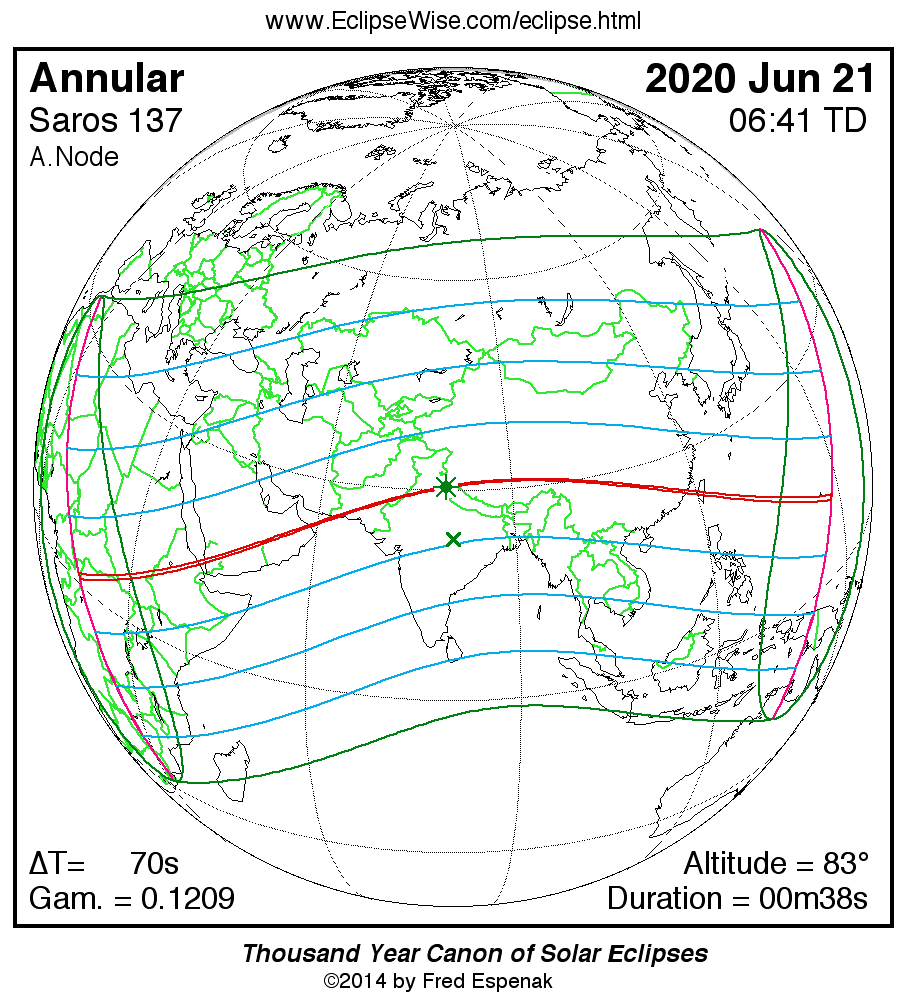
Click for larger more detailed figure
Annular Solar Eclipse of 2020 Jun 21
The first solar eclipse of 2020 is annular and occurs on the June solstice. The Moon is at its ascending node in Taurus and 6.2 days passed apogee. The narrow path of the annular eclipse crosses central Africa and southern Asia. The partial phases are visible from Africa, eastern Europe, and much of Asia (Figure 3).
The Moon's antumbral shadow first touches down on Earth at 04:48 UT along the border between the Republic of the Congo and the Democratic Republic of the Congo. The central line duration of annularity here is 1 minute 22 seconds. Racing across the African continent, the antumbra crosses South Sudan, Ethiopia and Eritrea before traversing the southern end of the Red Sea. The path passes over the Arabian Peninsula crossing Yemen, southeastern Saudi Arabia, and Oman.
By the time the antumbral shadow reaches the southern coast of Pakistan (05:50 UT1), the Sun's altitude is 62° and the duration of annularity is 45 seconds. Furthermore, the path width drops from 85 kilometers at its start, to 29 kilometers. These decreases in the duration and path width occur because the curvature of Earth is bringing the path closer to the vertex of the antumbral shadow. The duration and path width continue to decrease as the antumbra sweeps across Pakistan and northern India where greatest eclipse [5] occurs at 06:40:05 UT1. The Sun's altitude is 83°, the path width is 21 kilometers, and the duration of annularity is 38 seconds. The annular ring is quite thin because the eclipse magnitude [6] is 0.997 while the eclipse obscuration [7] is 0.988.
Leaving India, the shadow's trajectory takes it over a 3800-kilometer long track across southern China. As the antumbra reaches the coast, the city of Xiamen experiences a 56-second annular phase. Heading southeast, the shadow crosses Taiwan and out across the Philippine Sea and Pacific Ocean with no other landfall. The island of Guam lies just outside the northern edge of the path. Residents there will see a partial eclipse of magnitude 0.977 about ten minutes before sunset.
At 08:32 UT1, the antumbra reaches Earth's terminator and returns to space. Over the course of 3 hours and 43 minutes, the Moon's antumbra travels along a 14,600-kilometer long path covering 0.13% of Earth's surface area. Central line coordinates and circumstances are presented in Table 1.
Local circumstances and eclipse times for a number of cities in Europe and Africa appear in Table 2a, Western Asia in Table 2b, and Eastern Asia in Table 2c. All times are given in Local Time. The Sun's altitude and azimuth, eclipse magnitude and eclipse obscuration are all given at the instant of maximum eclipse.
The 2020 June 21 Solar Eclipse Circumstances Calculator is an interactive web page that can quickly calculate the local circumstances for the eclipse from any geographic location not included in Table 2a, Table 2b, and Table 2c.
This event is the 36th eclipse of Saros 137 (Espenak and Meeus, 2006). The entire series of 70 eclipses spans the years 1389 through 2633. Only 10 members of this series were total (in the years 1551 through 1695). Saros 137 also has 10 hybrid, 36 annular, and 15 partial eclipses.
Complete details for the 70 eclipses in the series may be found at Saros 137.
For additional details on this event, see the EclipseWise Prime Page on the Annular Solar Eclipse of 2020 June 21.
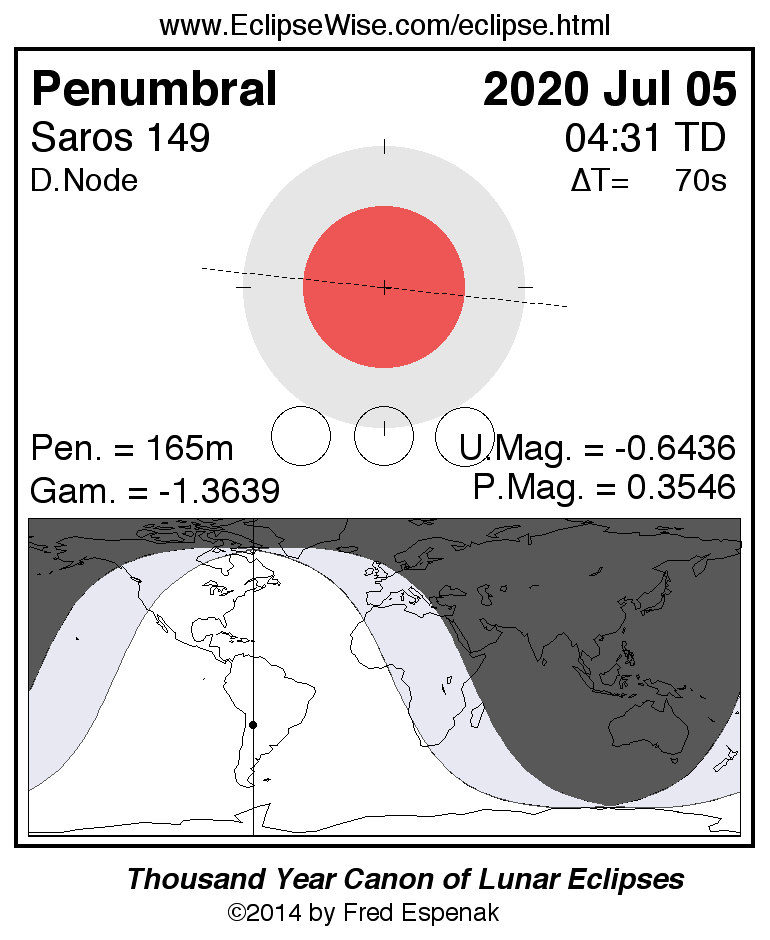
Click for larger more detailed figure
Penumbral Lunar Eclipse of 2020 Jul 05
The third lunar eclipse of the year occurs at the Moon's descending node in Sagittarius. Although it is a rather shallow eclipse with a penumbral eclipse magnitude of only 0.355, it is the first lunar eclipse of the year visible from the Western Hemisphere.
The Moon's path through Earth's shadow and a map illustrating worldwide visibility of the event are shown in Figure 4. The times of the major eclipse phases are listed as follows.
Penumbral Eclipse Begins: 03:07:23 UT1
Greatest Eclipse: 04:30:02 UT1
Penumbral Eclipse Ends: 05:52:27 UT1
At the instant of greatest eclipse (04:30:02 UT1) the Moon lies at the zenith for a point northern Argentina.
The eclipse belongs to Saros 149 and is number 3 of 71 eclipses in the series. All eclipses in this series occur at the Moon's descending node. The Moon moves northward with respect to the node with each succeeding eclipse in the series and gamma increases. Complete details can be found at Saros 149 .
For more information about this eclipse, see the EclipseWise Prime Page on the Penumbral Lunar Eclipse of 2020 July 05.
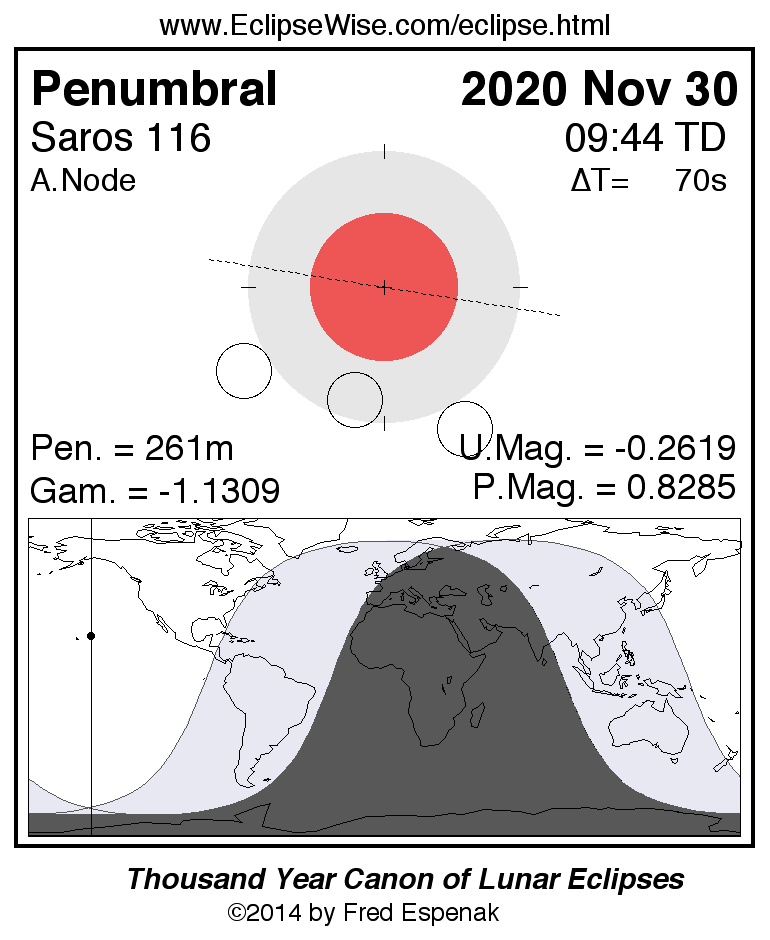
Click for larger more detailed figure
Penumbral Lunar Eclipse of 2020 Nov 30
The fourth lunar eclipse of the year occurs at the Moon's ascending node in Taurus. A much deeper penumbral eclipse than the previous one, the penumbral eclipse magnitude is 0.828, and it is also widely visible from the Western Hemisphere.
The Moon's path through Earth's penumbral shadow and a map illustrating worldwide visibility of the event are shown in Figure 5. . The times of the major eclipse phases are as follows.
Penumbral Eclipse Begins: 07:32:22 UT1
Greatest Eclipse: 09:42:52 UT1
Penumbral Eclipse Ends: 11:53:26 UT1
At the instant of greatest eclipse (09:42:52 UT1) the Moon lies at the zenith for a point near the Hawaiian Islands.
Once again the beginning and end of a penumbral eclipse are not visible to the eye. No shading can be detected until about 2/3 of the Moon's disk is immersed in the penumbra. This would place the period of eclipse visibility within about 1/2 hours of greatest eclipse (about 09:10 to 10:10 UT1). An interesting exercise is to note what time penumbral shading is first and last detected with the naked eye or with binoculars.
The eclipse belongs to Saros 116 and is number 58 of 73 eclipses in the series. All eclipses in this series occur at the Moon's ascending node. The Moon moves southward with respect to the node with each succeeding eclipse in the series and gamma decreases. Complete details can be found at Saros 116 .
For more information about this eclipse, see the EclipseWise Prime Page on the Penumbral Lunar Eclipse of 2020 November 30.


